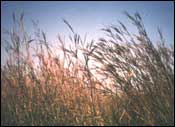- Mission Statement
- Background
- Henslow's Sparrow Report
- Objectives and Justification
- Partners in Flight High Priority Species
- General Vegetation Types and Data Sheets
- Size of Grassland
- Establishing Line Transects
- Sample Field Map
- Avian Surveys
- Vegetation Sampling
- JIZZ Descriptions and Species Codes
- Grassland Species in A.O.U. Check-list Order
- Suggested Reading
- Liability
- Acknowledgements and Miscellaneous
- Project Prairie Birds Release of Liability
 (PDF 271 KB)
(PDF 271 KB) - Project Prairie Birds Release of Landowner Liability
 (PDF 257 KB)
(PDF 257 KB) - Project Prairie Birds Vegetation Data Sheet
 (PDF 254.8 KB)
(PDF 254.8 KB) - Project Prairie Birds Bird Survey Data Sheet
 (PDF 254.9 KB)
(PDF 254.9 KB) - Project Prairie Birds Booklet without Species Photos
 (PDF 2.7 MB)
(PDF 2.7 MB)
Project Prairie Birds
A Citizen Science Project for Wintering Grassland Birds
Establish Line Transects

- Transects must be 100 m long and approximately 20 m wide; the three participants with extended poles that form the survey line is approximately 20 m wide (Figure 1).
- To avoid flushing birds from transect-to-transect, separate transects by at least 200 m.
- Transects adjacent to less-traveled roads should be placed approximately 10 m from the roadside and run perpendicular (away from the road, not parallel to it).
- Don’t establish a transect into the rising morning sun (which is roughly 40-140 degrees compass bearing); it's too bright.

Lark sparrow
Photo Copyright Michael L. Gray
Monument Your Sites
Mark your sites in such a way that they can be easily located in future years even without you present. This includes a general map of the area as well as a specific hand-drawn map of where each transect begins and ends (see example). It will be important to take slide photos annually of each transect from the same spot with some reference of scale (i.e., have a person standing in the grass at the same exact spot each year). Determining the location with a GPS unit is highly recommended, but not always feasible. Drive a brightly painted piece of rebar deep into the beginning of the transect making sure it is clear of cattle, humans, tractors, etc. Simple flagging has a very short life span since deer and cattle browse on them, while normal weather conditions accelerate rotting. Use tall t-posts, conduit, or PVC; use metal if your area is burned regularly.
We recommend driving a 4’ piece of rebar about 1-2’ deep in the ground with a 6’ piece of PVC slipped onto it. This is very visible and safe for cattle and tractors. Replace the PVC when needed (i.e., after a fire). Check your local hardware store for these very inexpensive items.
We recommend monumenting in the fall at least two weeks prior to a December avian survey.
We also recommend that a team establish no more than 10 transects total to avoid over-committing. Please conduct some practice runs weeks before your first official survey. The practice will help build confidence and field experience.
Figure 1
View of transect from above.

Tips:
- Watch out for large grasshoppers that flush from the grass; they can look like a pale sparrow from the corner of your eye.
- During avian surveys, never wear sunglasses since they distort colors that are very important when identifying a bird.
Sample Field Map
Notes/Directions:
In Anywhere County, drive south on Highway 3 for 6.2 miles south of the intersection of FM 691 and Highway 8. Turn left on gray gravel road. Proceed 3.1 miles to the start of the transect. Park at the old barn. Walk south 10 m towards windmill on horizon (175°) to first transect marker – a white PVC marker. See map below.
Project Prairie Birds Program
Texas Parks and Wildlife Department
4200 Smith School Road
Austin, TX 78744
or send a message to: nature@tpwd.state.tx.us
